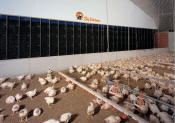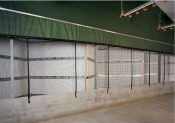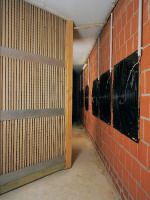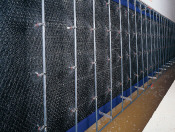



Exhaust air treatment systems for production facilities - what is their present performance spectrum?
By Lars Heyer, Big Dutchman International GmbH - Agriculture as source of environmentally hazardous emissions is entering more and more into the focus of public discussion, especially in regions with a very high livestock density.In Germany, only 6% of livestock-derived ammonia emissions can be attributed to poultry production facilities. However, a further reduction of emissions from this source is especially important in rural regions with high livestock densities.

As a matter of principle, a well-chosen house climate and control concept with innovative in-house emission reduction measures, as well as good house management are the first steps towards an effective reduction of emissions. A good example for these kinds of measures is the introduction of the manure belt ventilation system, which caused a significant decrease of the ammonia concentration inside the house. Because of this decrease, it was also possible to improve laying performance and animal health.
Beyond these in-house reduction measures, several feasible exhaust air treatment methods to remove dust particles, odour and ammonia have been developed. These exhaust air treatment systems work only in houses or sheds with forced ventilation (negative pressure ventilation), as only in these houses waste air is sucked or pushed through the respective filter medium. The correct exhaust air treatment system has to be selected, taking into account the volume flow, type of building, type of animal and the desired emission reduction capacity.
In order to be able to carry out a quantitative analysis regarding the emissions of livestock production facilities, German authorities use environmental factors such as the main direction of the wind, the geographical location, the height of the emission source and the initial level of emissions caused by possible other emission sources nearby to prepare estimates for spreading of dust, odour and ammonia. These estimates are used to create a map illustrating minimum distances between the poultry house and other buildings or forest areas, which is required to obtain a building permit.
 |
| At present, the easiest way to reduce dust emissions is with a mechanical dust filter. At the recent EuroTier in Hanover, Germany, Big Dutchman introduced the first mechanical dust filter worldwide for an effective and cost-efficient reduction of particle emissions from poultry production facilities |
 |
| Ventilators suck waste air through the double layer filter wall. |
 |
| If there is an extra-high need to reduce ammonia and odorous substances from waste air, it is necessary to implement a wet-type exhaust air washer. Such a system consists of one or more filter / cleaning stages - depending on the area of application. |
 |
| Water is sprayed through a group of nozzles on to the front of the first filter bank so the bank is kept from drying-out and dust is prevented from being deposited. This significantly increases the degree of dust recovery. Air flows into the filter bank, through which water flows constantly from top to bottom. This traps any dust and attached ammonia and odour particles and washes them out into the water basin. |
If the distance of a livestock production facility to sensitive areas remains under the allowed minimum distance, it is possible that the permit to build the facility will not be granted, or it will be granted under the condition of installing an exhaust air treatment system.
German authorities, however, typically accept only officially certified systems that have proven themselves in practice over an extended period of time. Therefore, equipment manufacturers who want to become active in the field of exhaust air treatment have to apply for permission for a test house and must test their exhaust air treatment system for its feasibility and performance, obtaining official measurements from a certified measuring company.
Concerning poultry production, dust particle emissions is a topic that is becoming more and more important in Germany, as alternative housing systems for layers and broiler production facilities produce a lot more dust than conventional cage systems.
At present, the easiest way to reduce dust emissions is by means of a mechanical dust filter. At last year's EuroTier in Hanover, Germany, Big Dutchman introduced the world's first mechanical dust filter for an effective and cost-efficient reduction of particle emissions from poultry production facilities. The innovative principle of action is very simple but incredibly effective.
StuffNix consists of a perforated, double layer filter wall in which the air that flows through is subject to strong changes of direction. By means of the simple, mechanical principle of action of separation through centrifugal force, dust particles are separated from the air flow. They are collected in V-shaped chambers outside the air flow. Thus, the way for the cleaned air stays free, even though the filter fills up with dust particles. The flow resistance stays at a low level and does not increase. With regard to a responsible use of natural resources and the shortage of water in many regions, this type of dry filter is an efficient and favourable alternative to reduce dust emissions without having to implement a wet-type exhaust air washer.
To clean the dry-type dust filter, simply shake the filter wall and attached particles will loosen and fall to the floor. From there they can easily be removed. Due to its simplicity, investment costs for this type of filter lie at approximately 3000 € (for an exhaust air performance of 100.000 m3/h). Operating costs lie at approximately 800 € per year. Qualified measurements have confirmed a dust recovery of approx. 70%. As ammonia and odour particles are also attached to dust, parts of these emissions are already filtered out of the exhaust air.
If further reduction of ammonia and odour particles from the exhaust air is required, it is necessary to install a so-called wet-type exhaust air washer. Such a system consists of one or more filter / cleaning stages, depending on the area of application. Water is sprayed through a group of nozzles on to the front of the first filter bank of an exhaust air washer, keeping the bank from drying out and preventing dust from being deposited at the filter. Through this process, the degree of dust recovery is significantly increased. Air flows into the filter bank through which water flows constantly from top to bottom. This traps dust and attached ammonia or odour particles and washes them out into the water basin.
With acid added (e.g. sulphuric acid), the separation of ammonia can be significantly increased. Dependent on the pH-value of the wash water, the addition of acid is accomplished by an automatic dosing pump. In the wash water the ammonia combines chemically as ammonium sulphate, preventing the evolution of ammonia gas (NH3).
The basin has to be emptied at regular intervals. The waste water can be returned to the agricultural cycle and used as fertilizer. Compared to a simple dust filter, an exhaust air washer has more technological requirements (pump, water etc.) and requires more intensive regular maintenance. Even though this results in higher investment and operating costs, the advantage is that in a well-controlled one-stage system with additive dosing, the odour reduction can be higher than 70%. In some cases, smell is already no longer perceivable even at a distance of just 10m away from the exhaust air cleaning system.
Conclusion: emission-reducing measures are important for a healthy environment for both humans and animals. Depending on the target degree of efficiency, there are several different but very practical exhaust air treatment systems available to effectively reduce emissions. However, before using any exhaust air treatment technology as an additional tool, all other possibilities should be used to their full potential to effectively reduce emissions already where they originate, inside the house.









